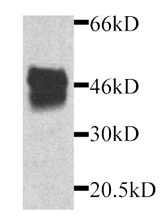
Western blot detection of GFP-MIP2 fusion protein in transfectant by anti-GFP.
GFP antibody
GTX30266
ApplicationsImmunoPrecipitation, Western Blot, ImmunoHistoChemistry, ImmunoHistoChemistry Frozen
Product group Antibodies
ReactivityOther Species
Overview
- SupplierGeneTex
- Product NameGFP antibody
- Delivery Days Customer9
- Antibody SpecificityThis antibody reacts with wild-type GFP, and its variants, such as EGFP, EBFP.
- Application Supplier NoteFor IP: Use at a dilution of 1:200-1:500. For WB: Use at a dilution of 1:5,000. Optimal dilutions/concentrations should be determined by the researcher.
- ApplicationsImmunoPrecipitation, Western Blot, ImmunoHistoChemistry, ImmunoHistoChemistry Frozen
- CertificationResearch Use Only
- ClonalityPolyclonal
- Concentration1 mg/ml
- ConjugateUnconjugated
- HostRabbit
- IsotypeIgG
- Scientific DescriptionThe jellyfish Aequorea victoria contains green fluorescent protein (GFP) that emits light in the bioluminescence reaction of the animal. GFP has been used widely as a reporter protein for gene expression in eukaryotic and prokaryotic organisms, and as a protein tag in cell culture and in multicellular organisms. As a fusion tag, GFP can be used to localize proteins, to study their movement or to research the dynamics of the subcellular compartments where these proteins are targeted. GFP technology has revealed considerable new insights into the physiological activities of living cells.
- ReactivityOther Species
- Storage Instruction-20°C or -80°C,2°C to 8°C
- UNSPSC12352203
References
- Adeno-associated virus 2/9 delivery of Cre recombinase in mouse primary afferents. Abdallah K et al., 2018 May 9, Sci RepRead more
